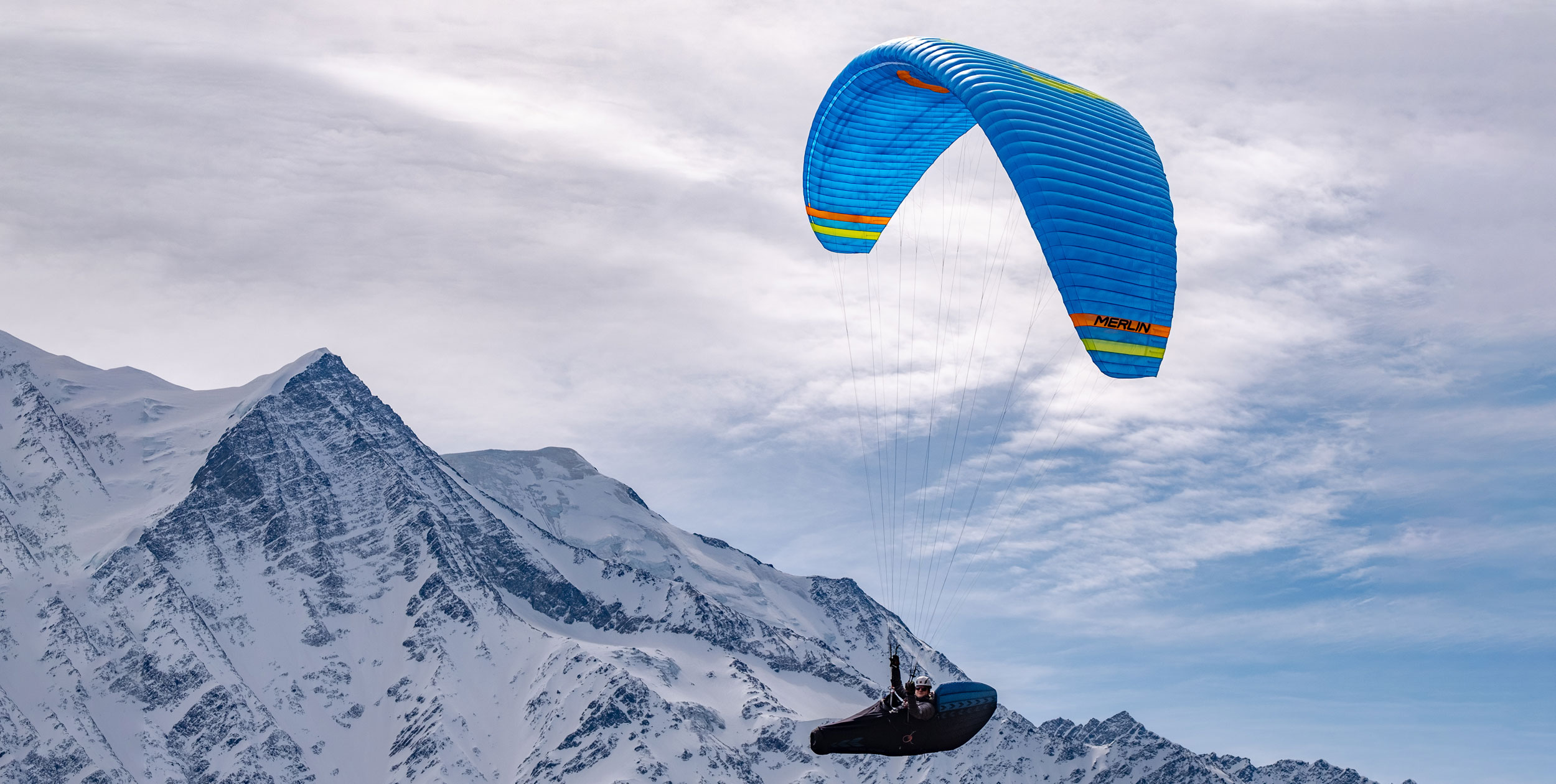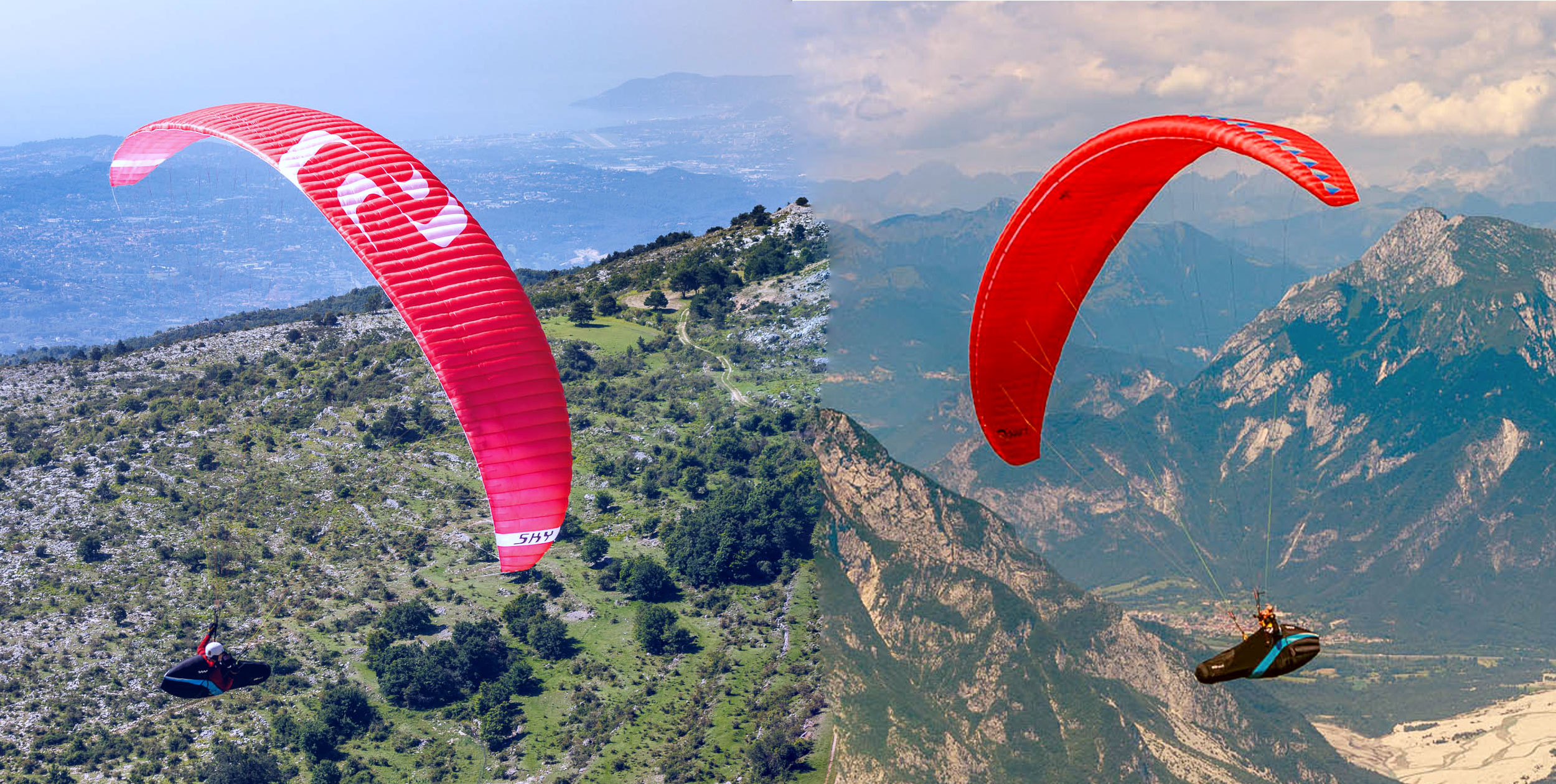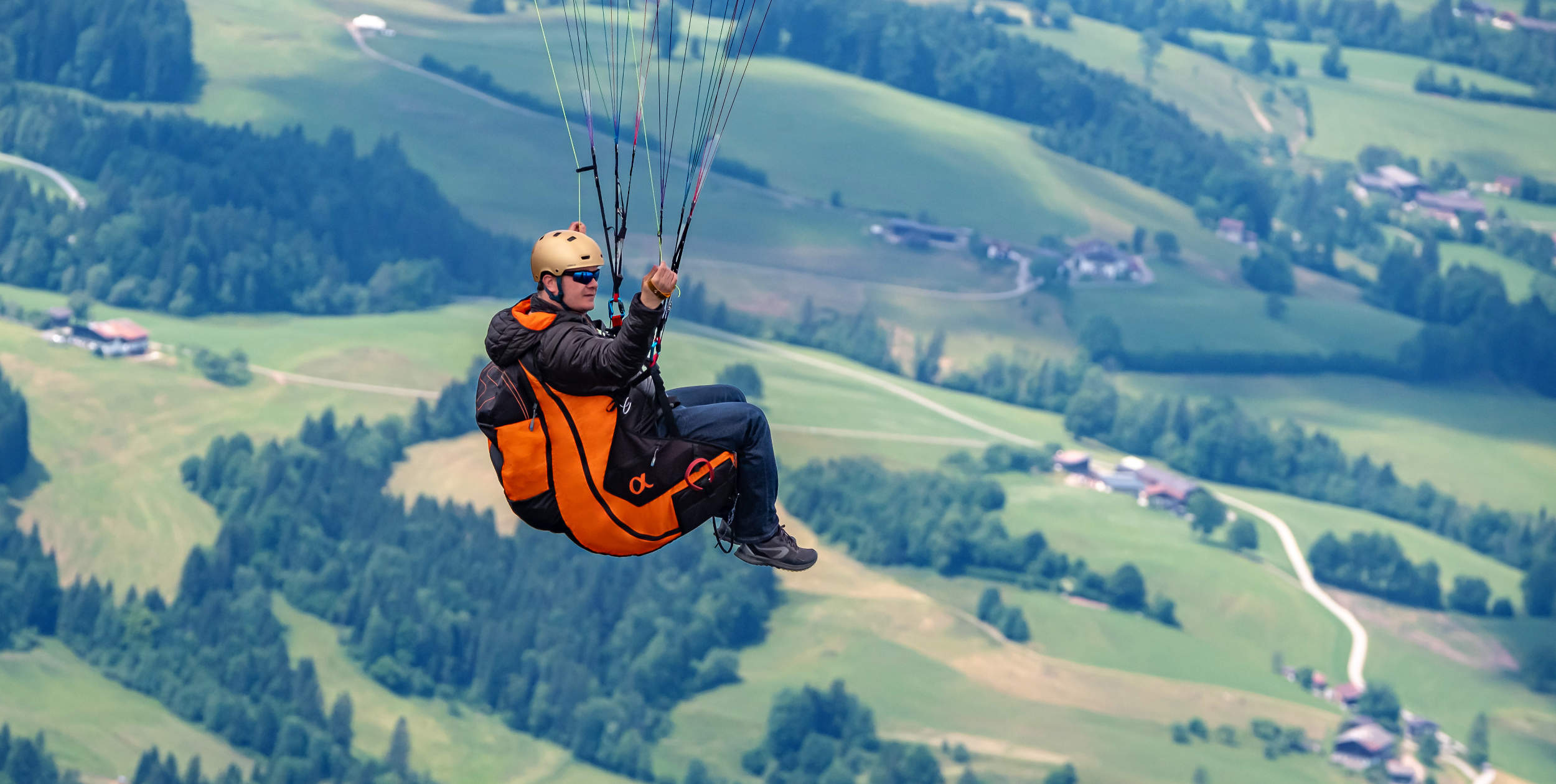Those crazy dudes… A Sky Atis 2 paraglider, a later model from the one reviewed here, gets taken for a rollover by Sebastien Fabre
Paragliding in Eastern Europe is booming and as the sport grows, so too do its resident manufacturers. Following their 2001 World Championship victory, Gradient have firmly stamped their presence on the world scene, but they’re not alone in enjoying full order books. Ian Blackmore tests the latest intermediate from the Czech Republic’s other great rising star, Sky Paragliders. First published in Cross Country magazine in 2003
Back in 1988, deep behind the USSR’s Iron Curtain one man was on a mission to make himself a nine-cell paraglider. And in so doing, Marko Malovrh founded Sky Paragliders. By 1992, the company had mushroomed to supply a growing number of Slovenian pilots, and Marko teamed up with business partners in the Czech Republic to manufacture a full range of gliders, harnesses and reserves.
Sadly, Marko died in the 1998 European Championships after suffering a mid-air collision, and subsequently the company moved to the Czech Republic where production costs were lower. Sky’s designer is Switzerland’s Alexander Paux. Following a switch from SHV to DHV certification in 2000, and with a dealer network now established in 21 countries Sky have made serious inroads into the European market most notably Switzerland, where the Atiss predecessor, the Lift, now has a strong following.
The Brief
“Are we making gliders to please ourselves, or our customers? We must ask ourselves, are we the best judges of what makes a nice wing?” Alexander Pauxs reasoning has substance and truth, yet his philosophy is at odds with many in the world of paragliding design.
“Most of our customers only fly 30 to 50 hours a year” he continued, “and their tastes as to what makes a comfortable wing may differ significantly to those of the professional designers and testers who fly 300 to 500 hours a year.”
Sky have pioneered a program where non-professional pilots similar in ability to their target customers give feedback on the new designs prior to final trimming. This is a possibly unique approach, but Sky arent afraid to question whether their way of development is correct.
“We try to make gliders that please the customer from the first flight.” To achieve this, Alex said the main aim is to produce a glider that handles well and is nice to use. “Lots of time is spent in thermalling tests getting the glider just right.”
Construction
Thankfully, paragliding manufacturers buried their early 80s fetish for lurid fluro colours but they now seem to be going through a period of almost monastic dullness of designs when it comes to accessories, flying suits and bags. Whether this is a good thing I’m still not sure; it’s all down to personal taste.
The Atis comes in a plain black rucksack, a safe colour for most tastes but a logo or even a little coloured stripe would certainly have brightened things up a bit. Well made and with several nice pockets, it is sadly too small to accommodate both my Pro Feel 2 harness and the glider without judicious use of my not inconsiderable bulk to compress things.
As for getting the helmet in, forget it. Similarly the inner bag is positively stingy. The drawstring was even too short to allow it to open fully. Hopefully this will be sorted out soon. Sky assured me that they are developing a bigger bag as I write.
Thankfully the wing itself has received better attention. Made from Porcher Marine Skytex 9017 and a combination of Edelrid dyneema upper and kevlar lower lines, the wing features the now almost derigeur diagonal ribs with line attachments every third rib and diagonals either side of each line.
All stitching is internal and of good quality. There are four risers black in colour, with the A riser being split to allow easy big ears. All the risers are coded with coloured fabric over each riser (this non-structural cloth started to fray around the edges by the end of the test).
Plastic inserts are used to keep the lines tidy within the stainless steel quicklinks. There is a typical speed system arrangement on the A-riser using a 3:1 reduction but no Brummel hooks. Brake handles are perfectly comfortable and clip securely to the rear riser via magnetic poppers.
The Atis is conventional in its design, with no closed leading edge cells, and sports a slightly old fashioned planform with pointy wingtips that disguise its relatively high aspect ratio. Rather than concentrating on high profile new vents to raise performance, the Atis’s performance and handling secrets are down to aerofoil sections and subtleties of trim.
Alex said the pointed tips are a result of concentrating the main lifting area of the wing towards the centre, which results in less tendency to turn during asymmetric collapses. The old problem of pointy tips collapsing and flapping all the time has been overcome by using different aerofoil sections that resist collapses over a far wider range of angles of attack than previously.
Launching
The Atis’s predecessor, the Lift, had a problem launching and Sky admit it. Since a number of their existing customers fly paramotors, Sky considered it essential that the Atis performed well in this respect. With that in mind the Atis was developed from the Brontes performer, which incorporates newer aerofoils and design ideas to the other older wings in the range.
The result seems to have worked, leaving me very little to say about the Atis launching characteristics other than it is extremely well sorted. I always kept the split A risers velcrod together for launching and never had the need to use the centre As on their own for any reason. Building a wall is simplicity itself in stronger winds and during both forward and reverse launches, the wing accelerates smoothly overhead with little or no tendency to hang back, overshoot or wander off course.
Performance and Handling
Launching into smooth air at England’s Devil’s Dyke, the Atis inflated and took off in an easy and unspectacular manner. Speed and glide away from the hill feel fairly typical for its class. Any experienced or competent pilot in smooth air will immediately feel at home and reassured by its almost “familiar” feel.
My interest built as I started to explore the handling of the Atis. Experimenting with pitch-induced oscillations, gentle turns and wingovers began to trigger memories and again that “familiar” feeling. As my confidence in its handling grew, I started to realise where it was coming from.
The Atis handling is reminiscent of an older generation of wings where perfect handling rather than outright performance in class was the designer’s priority. The two wings that sprang to mind were the FreeX Flair and ITVs Agena. In their day neither of these wings were class leaders in performance but were hugely loved by their owners due to their easy, lively handling and an intangible fun factor.
The effect was a state of mind that encouraged you to search out stronger, rougher thermals and bank up steeper in climbs just for the hell of it. Having enjoyed outclimbing pilots on higher performance wings the temptation was to spiral or wing-over straight back down and do it all over again.
The Atis is a wing with handling from the same mould as the Flair but with modern performance, and is superb fun. Its instant responses and great co-ordination in turns make wingovers, porpoiseing, and sudden steep turns and spirals a real delight for a competent pilot.
The manual makes the point that it is not a wing for novice pilots buying their first wing and this is borne out in practice. It has no vices, but its directness and liveliness mean that it will react instantly to an incorrect input.
Although this will not usually result in a collapse, poorly timed or badly measured inputs will be immediately rewarded by the clumsy pilot with unwanted pitching and rolling. This is not a criticism, more of a characteristic and a by-product of handling that allows competent pilots to place the wing precisely where they want even in powerful thermals.
As far as its outright performance goes, I measured a trim speed of 36 km/h and an accelerated speed of 48 km/h exactly what Sky advertise. I had a good comparison flight with photographer Felix Wolk on his Vibe and the two wings seemed very comparable.
Straight-line performance was similar, with the Atis gliding at a marginally higher trim speed but slightly worse sink rate. Glide angle appeared identical. The Vibe had a slight edge in weaker thermals and the Atis in tighter stronger cores. The Atis’s sink rate when thermalling is surprisingly good considering the angles of bank it naturally tends to assume however, the stronger and smaller the core, the better the Atis performs against other wings.
Safety
The Atis is extremely resistant to collapses. After gaining a first impression on my home ground of Devil’s Dyke, the Atis underwent a more thorough workout during a week’s flying in Billing, India. Surprisingly though, one of the most turbulent climbs was above Devil’s Dyke on my return. Throughout the test, despite repeated, broken and choppy climbs and thermals from 4-8 m/s in strength, the Atis suffered not one collapse and never once gave a hint of being pushed out of stronger cores.
Lively handling – the Atis’s greatest strength – can become a weakness in strong conditions; it all depends on the pilot. An active wing with high feedback levels combined with precise and accurate controls can easily see the unskilled pilot mistiming or over-controlling when conditions get strong.
At best the novice will not enjoy him or herself and at worst might suffer a collapse. In its favour, the good feedback levels leave you in no doubt as to the strength or roughness of conditions unlike some wings, which can blinker the novice pilot to the dangers of the day. Should it all go horribly wrong, the Atis’s collapse resistance and recovery characteristics should let you escape with a lesson learnt the easy way.
After even the mighty Himalayas had failed to get the Atis flapping, it was time to start pulling strings again. It’s not easy inducing asymmetric collapses at trim speed on the Atis. It really does resist any attempt to deform the leading edge.
A hefty pull on the riser will eventually take out one side but the collapse is pretty mundane and recovery is unaided and almost instant within considerably less than a quarter turn. Once fully accelerated, 70% assymetrics are easier to achieve with a resulting quarter to half turn and rapid spontaneous recovery.
Countering turns is easy and requires no great precision to maintain a straight course. Wingovers are extremely easy due to lovely co-ordination, and spirals are easily entered but require some care when exiting in order to avoid large and unpleasant conversions, as mentioned in the owner’s manual.
The owner’s manual for the Atis deserves special mention here. It is simply one of the best I have ever come across and really is an aid to pilot safety. Often something overlooked or neglected by manufacturers, the owner’s manual is the pilot’s first point of reference as to what to expect from a wing and any quirks it may have.
The Atis manual does this in the manner of the best instructors, with no marketing hype or bullshit, covering everything you need to know, clearly, concisely and accurately. It is quite rightly not a “how to fly manual,” but a manual that tells the qualified pilot everything he needs to know, and what to expect when flying and maintaining this particular wing.
Summary
The Atis is an intermediate wing that any competent pilot will enjoy flying. The handling is direct, precise and lively with nicely weighted linear controls. In many ways it handles a bit like an Epsilon 3 but with even more agility, which simply makes it more fun. It did not feel like a class leader in performance but it is close to the best.
If fun handling is your priority then this could well be the wing for you. Its nimbleness and agility when climbing may well over-ride any slight loss of outright performance over wings like the Oasis. If however, trundling along with minimum pilot input, isolated from turbulence and feedback is more your style, then look elsewhere.
TECHNICAL DETAILS
S M L
Weight Range (kg) 60-85 80-105 100-130
Area Flat (m2) 25.2 27.4 29.6
Area Projected (m2) 22.16 24.09 26.01
Span Flat (m2) 11.34 11.82 12.29
Span Projected (m2) 9.3 9.69 10.07
Aspect Ratio Flat 5.1 5.1 5.1
Aspect Ratio Projected 3.9 3.9 3.9
Cells 43 43 43
Glider Weight (kg) 5.7 5.8 5.9
DHV Certification 1/-2GH 1-2GH 1-2GH
TEST DETAILS
The Atis L was tested over a three week period in Billing, India and the south of England using a Sup Air Pro Feel 2 Harness. The flying weight for the test was 120 kg. Conditions ranged from smooth ridge soaring to 8m/s thermals at up to 3,500 m.
• Got news? Send it to us at news@xccontent.local
Subscribe to the world’s favourite hang gliding and paragliding magazine







